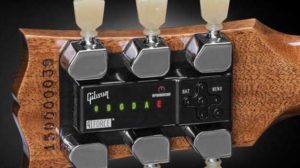There are various ways of tuning the guitar. For beginners, this can be a bit of a struggle at first, but the more you’ve done it the easier it gets. The first thing about tuning is that the tighter a string is on the guitar the higher in pitch it is. Acoustic Guitars For Beginners usually are easier to tune, since they have less room to play on.
So if you turn the tuning peg to tighten a string, then it will raise the pitch, slackening it, will lower the pitch of the string. The tuning pegs are the 6 key like things found at the top of the guitar, where the strings are attached. The notes of the 6 strings, when played without fretting any notes on the fingerboard are as follows, going from thickest/lowest pitch to the thinnest/highest pitch string: E-A-D-G-B-E.
If you have a problem remembering this, make up a way that will jog your memory, something like the following:
Eddie Ate Dynamite, Good Bye Eddie.
There are two possible ways to tune a guitar. One is to tune it to a reference note and the other is to use a device that can tell you if your guitar is in or out of tune.
Tuning Your Guitar Using A Reference
Using a reference, you find an example of one of the notes, listen to it and then turn the tuning peg until you have the same note. Pitch pipes can be bought from musical stores for around $5 which have the six notes required. You just blow into the relevant note and tune the string to it. These can be hard to tune to for beginners as the notes from the pipes have a very “reedy” sound. Another option is to buy a tuning fork with one of the above notes and tune to it. Another method is to use a keyboard, synthesizer or piano to produce the reference notes required for tuning. If you can get one string into tune then you can use it to tune all of the other strings on the guitar, using the following table.
| String | Action |
| E | Holding down the 5th Fret produces an A note which you can use to tune the A string. |
| A | Holding down the 5th Fret produces an D note which you can use to tune the D string. |
| D | Holding down the 5th Fret produces an G note which you can use to tune the G string. |
| G | Holding down the 4th Fret produces an B note which you can use to tune the B string. |
| B | Holding down the 5th Fret produces an E note which you can use to tune the E string. |
So for example, if you managed to tune the D string with a tuning fork, or other, then hold down the D string at the 5th fret which will produce a G which you can tune the G string to. Hold down the A string at the 5th fret which should produce a D like the string you’ve already tuned, so turn the peg until the fretted D sounds like the open D string, etc. When using this method some people like to play the two strings together, and let them ring out so that you can then turn the peg and hear it tuning to the new note. I prefer to play the reference note and remember the sound and then tune the next string until it sounds like the reference note. It is best to use the method that you find easy. If you haven’t played the guitar before, I recommend you take a look at our buying guide for the best guitar strings for beginners. Beginner strings are usually softer on the fingers and are easier to tune.
Tuning With An Automatic Tuner

Usually, there is a switch present that allows you to select the string you are tuning. The one I use and prefer is a chromatic tuner. These cost a little more, but I think it is worth it at around $35. The difference is that it allows you to tune to any note and you don’t have to select which note you are on. You just play the string, it reads out which note it is currently near and you tune to the one you desire.
They allow the full range of musical notes to be tuned, not just the six used by guitar, and hence that’s what you pay the extra money for. This comes in handy if you have other instruments to tune, or if you wish to tune your strings to other notes. If you are having trouble finding a guitar tuner, i recommend you read our article about the best clip-on guitar tuners.

